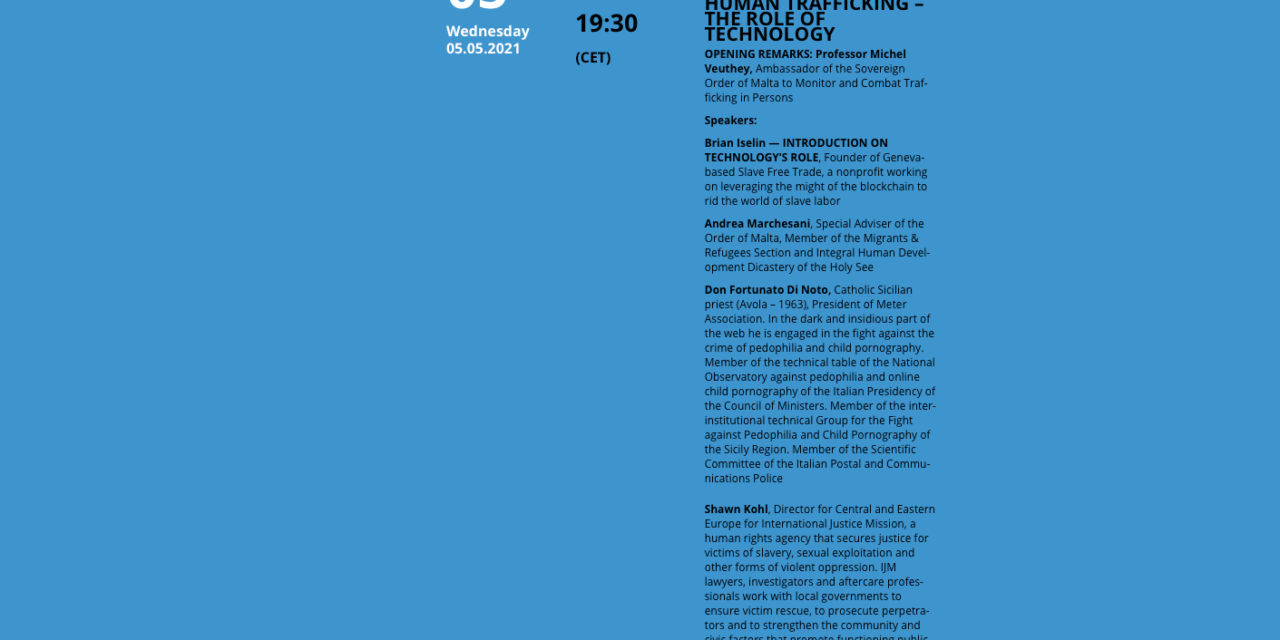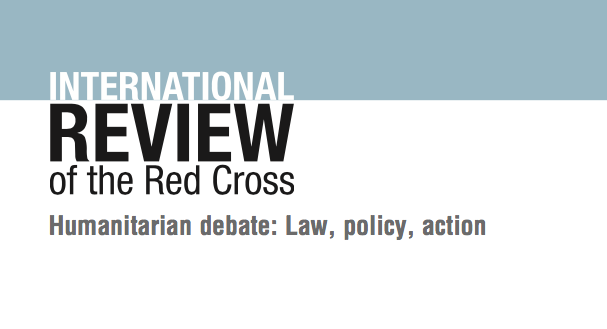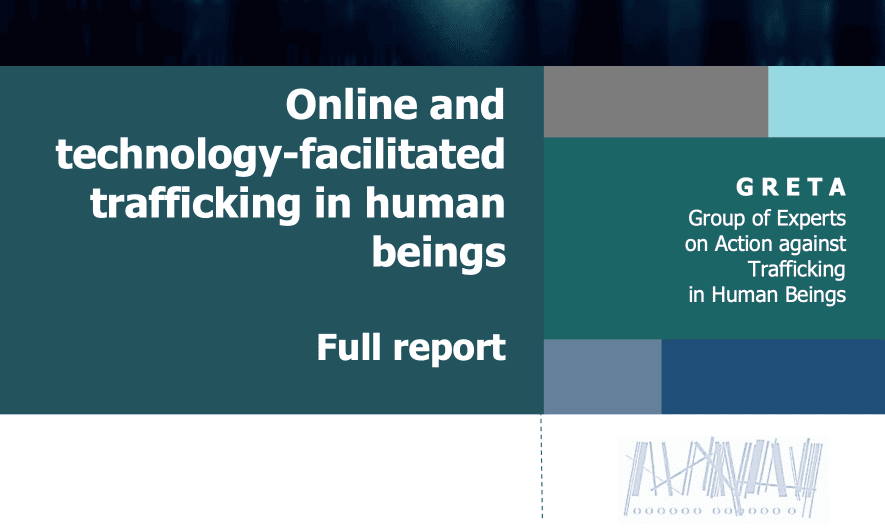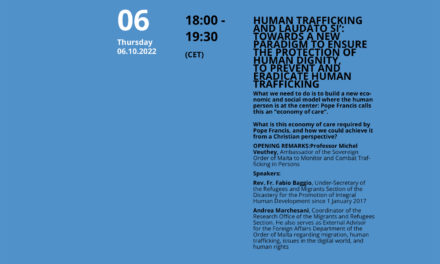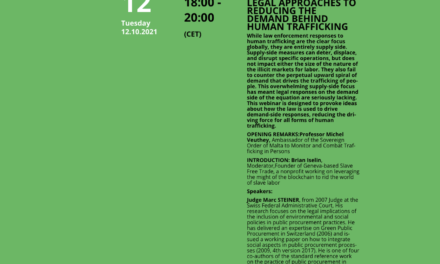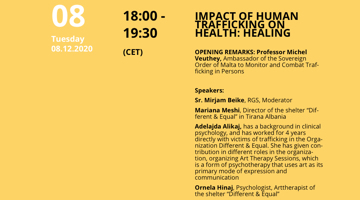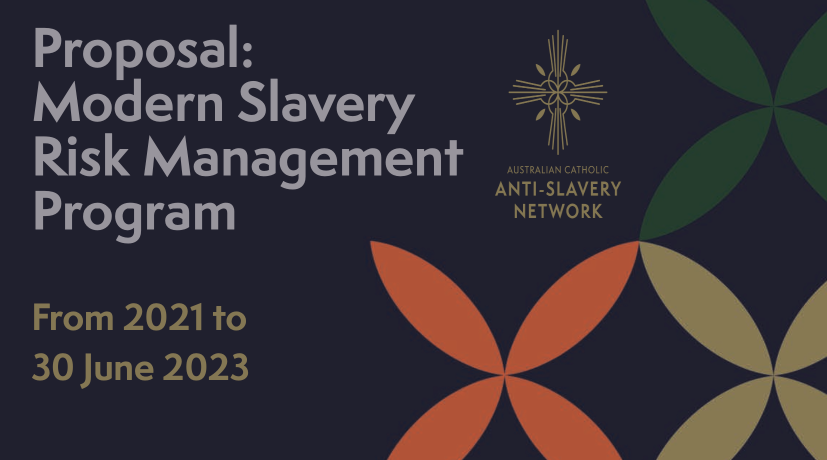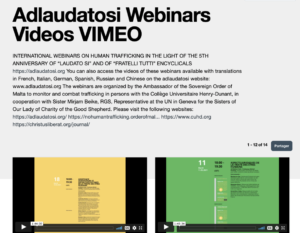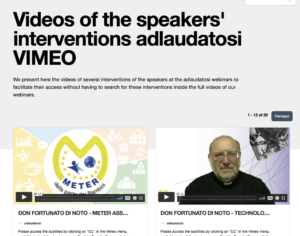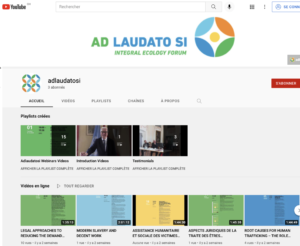TEXT OF THE MAY 5 WEBINAR: — “ROOT CAUSES FOR HUMAN TRAFFICKING—THE ROLE OF TECHNOLOGY”
MICHEL VEUTHEY: Welcome to the last of the three webinars on Demand as Root Cause for Human Trafficking. Today, we shall discuss technology, the role of technology in human trafficking. On behalf of the Order of Malta, I would like to thank Brian Iselin for his active participation in the organization of this webinar. As you know, Brian Iselin, founder and CEO of slavefreetrade, is a pioneer in the demand-approach against human trafficking, and specialist in the control of supply chains through technology, with 25 years of field experience against human trafficking. My thanks also to Sister Mirjam Beike for her help in the preparation of this and previous webinars. Technology, as we shall discuss today, can be used to trap as well as to protect victims. We should speak or we could speak of the use and misuse of technology in human trafficking. Today, we are very fortunate to have four distinguished speakers. First, Brian Iselin, who will be the moderator and speaker. Former Australian soldier and federal agent, founder of the NGO slavefreetrade, working on eliminating modern slavery on the workplace. Then, Andrea Marchesani, Special Advisor of the Order of Malta, and also Member of the Migrants & Refugee Section, of the Integral Human Development Dicastery of the Holy See. The third speaker is Don Fortunato Di Noto, Catholic Sicilian priest, President of the Meter Association. In the dark and insidious part of the web, he is engaged in the fight against the crime of pedophilia and child pornography. And the fourth speaker is Shawn Kohl, Director for Central and Eastern Europe for International Justice Mission, IJM, a human rights agency that secures justice for victims of slavery, sexual exploitation and other forms of violent oppression. Documents related to technology and human trafficking can be found and downloaded in the “Handouts” next to the chat at the top right of your screen. A special thanks again to Brian Iselin, who is now taking over as moderator. Brian, you have the floor.
BRIAN ISELIN: So thank you very much, Michel, and welcome, everybody to this webinar on the role of technology in addressing demand in human trafficking. I want to kick off this session with a plea for some clarity and use my time, I hope wisely, to address something I’d noticed before, but which really came into specific relief while researching for this webinar. While looking for evidence of impact, outcomes, and sustainability data from the major tech against trafficking projects, I actually found none, universally. What I did find, however, was how so many projects they claim to be contributing to ending, eliminating or eradicating trafficking. Now the terms that are used to describe actions being taken for the most part are frankly a little bit hysterical. You find, “eliminate”, “fight and eradicate”, “tackle”, “war against”. It’s all tough talk and I think it’s, very political. But what does it mean? A quick scan of initiatives, especially in the tech world at the terms used, just shows to me that there’s very little thought about the meaning and impact of those words beyond some kind of sensationalism. Now, my plea is that before using these terms to describe an initiative, I would ask people to consider the realistic impact a single initiative can lay claim to. And is the claim accurate or hyperbole? Now, if you’re working to support victims of trafficking, you’re not ending, eradicating or eliminating modern slavery. You’re helping victims, you’re cleaning up and you’re undoubtedly doing good, but you’re not ending, eradicating or eliminating. If you’re doing anything on the supply side, in fact, like rescues, identifying victims, police or intelligence operations, poverty reduction, you’re not ending or eliminating modern slavery. You are at best addressing vulnerabilities and cleaning up. You may even be confronting it or attacking it if that language is exciting for you, but you aren’t ending it, eradicating or eliminating. If you’re working on reducing demand for a form of human trafficking, you may honestly say you are working to end, or eliminate, or eradicate, but it’s only on the demand side. Which is why this webinar is so important. This series of webinars on demand is so important. Let me be clear. There is not a single supply-side measure that can ever hope to end, eliminate or eradicate. If you work on the supply side, just stop using that language. It’s hyperbole. The reason I raise it is actually bigger than the fact that it’s hyperbole, the fact that it’s sloppy and sensationalist. It’s confusing to consumers. It’s confusing to donors. It’s confusing especially to policymakers, and crucially, what we end up with is funds that should be used to ending, eliminating or eradicating modern slavery, being used to clean up or to address vulnerabilities. It’s behavior that distorts policy and priorities. And overall, I think it leads to a global lack of impact. So now that I’ve got that off my chest, I’d like to be able to talk about one of the only demand-side tech projects out there. I don’t know whether you know the phrase, the Latin phrase, “Esse Quam Videri”. “To be, not to seem”. Now, this is the motto of slavefreetrade, a Swiss nonprofit association I formed at the end of 2018. The meaning of this motto is at the heart of the initiative. I’ve been working decades on slavery operations in supply chains, and largely I found that businesses are content with seeming to be doing something, not actually doing something. And by and large, stakeholders, including consumers, procurement agencies, shareholders and investors are content with the “seeming”. I’m happy to report, I think, that this has changed. The world is now kind of abuzz with initiatives in the business, UN, and nonprofit world, to come to terms with an increasingly engaged, maybe we could even say sometimes agitated community of stakeholders interested in human rights performance and risk in business. We’re seeing shareholder revolts over serial sexual harassment. We’re seeing child labor scandals in major clothing brands and the promotion of sustainability professionals into key leadership roles in companies. Human rights are suddenly coming into focus a bit more. It would be going too far to say there is momentum, but perhaps we can agree that there is at least the movement. And this movement coincides with significant legislative movement in that direction from the Modern Slavery Act slipping the Anglophone world, to human rights due diligence models in the Francophone and the European world. Now taking a step back to take in the view, the corporate world, which was formerly content to use its blend of structural, instrumental, let’s say, discursive power to hold back the forces of change in their business model, are finding that position less tenable. Clever businesses, those with an eye on the emerging world, are exploring what that wave of change means to them and what they need to do to ride it. How does a business be and not just seem to be interested in human rights in workplaces? The first step as Socrates said, to wisdom, is to know thyself. Now, if you’re interested in human rights in workplaces, it can’t be only about them and over there. That’s called othering. And it’s the very core of the belief that we’re better than everyone else. And it also is the foundation that we think we are beyond reproach. If you genuinely care about human rights in workplaces, start at home. Human rights issues don’t just happen over there. Witness the MeToo Movement, and the BLM Movement. So let’s start with some background on the actual problem we’re addressing here. Universally, we condemn modern slavery and we’ve talked about this in past webinars and we prohibit it, and yet we all buy it. We touch modern slavery every day more often than we actually touch our faces. And thanks to Covid, we’ve become very aware of how much we touch our faces every day. Slavery, encompassing the illegal conditions of child labor, human trafficking, forced labor, slavery and servitude, is now more prevalent than at any time in history and we’ve heard these numbers over the past few weeks. 77% of UK businesses when given anonymity, admit modern slavery exists in their business. Historically, we are used to modern slavery being addressed as a form of organised crime. Well, historically, since the year 2000. But that conceptualization is far from actually accurate. The vast majority of the world’s human rights issues in workplaces, forced labor, child labor, slavery and servitude have little or nothing to do with organized crime. And law enforcement, in fact, can never solve modern slavery anyway. So law enforcement or crime-focused approach is not the solution. Modern slavery is actually best understood as that kind of bad, eroded end of a spectrum of human rights in workplaces. The spectrum being from modern slavery to decent work. Now, if you can objectively prove a workplace is at the decent-work end of the spectrum, modern slavery will not be present. You cannot be at opposite ends of the same spectrum at the same time. So if we can automate and scale rigorous real-time processes to understand exactly what’s happening in a workplace, we can determine whether they are at the decent work end or the modern slavery end. So we can do this through assessing and monitoring conditions in real-time. And what I propose, what I am developing, is a carefully selected set of 100 indicators derived exclusively from international human rights law. So for this exercise, picture, a long row of 100 escalators in a mall running off into the distance. At the foot of these escalators is the murky swamp of modern slavery. At the top of the escalators is this world of decent work. Now, what if I told you you could know at all times which step you are on for each of those 100 escalators, and whether you’re moving up or down? Well, that’s the project slavefreetrade. So we’re a Swiss nonprofit association, and what we want to do is foment a new global economy exclusively for goods and services proved to have been made without harming anyone, and we do that through harnessing demand. We envision a world in which an investor can scroll through the New York Stock Exchange Connect App, and see exactly which companies are human rights friendly and risk-free. In that same world, a millennial looking at a job in Glasdoor can readily identify a human rights-friendly employer. A shopper looking at prawns or chocolate in a supermarket can know which ones have not harmed anyone in the making. A procurement agency, the Ministry of Defense, evaluating bids for army boots, can see at a glance the human rights performance of the maker. This is harnessing demand. “Libertas”, it’s a rights-tech project of slavfreetrade. It’s the use of technology to extend, expand and promote human rights. It’s an initiative designed to provide the scalable tools for the mission of that new economy. It’s a technical term. It’s a distributed human rights intelligence system. It’s designed specifically to drive demand for human rights-friendly workplaces globally. It harnesses the compelling power of primary source data from workplaces, that’s individual views and organizational perspectives alike. It analyzes and distributes the resulting decision intelligence to those whose buying and business decisions can be influenced by that data. Our approach is not to prove modern slavery exists in workplaces. That’s what I’ve been doing the last 20 years, and it’s completely unscalable. But actually, our approach is to prove modern slavery doesn’t exist in workplaces. And that sounds like such an easy flip, right? But this is actually a watershed moment. This shift signals a move from a treatment model to a vaccination model. Instead of treating each case after it’s happened, we prove and create a culture of respect for human rights in a workplace, ushering in a world of workplaces that are impervious, vaccinated, against modern slavery. So slavefreetrade is an initiative designed with system seeking to overcome and avoid many of the problematic issues and concerns around all existing methods. So up until now, human rights defied quantification. So “Libertas” quantifies human rights, which means we’re able to monitor, assess and compare in a way that’s completely agnostic to product, geography, industry, socioeconomic conditions. Existing responses like rescues and audits, and investigations like I’ve been doing, cannot scale. They’re labor-intensive, they’re expensive. So “Libertas” is designed to be scalable, remote, cheap, global coverage, and takes out intermediaries from the system where failure often comes. Current models, most of you who know about audit will support me on this, are easily defeated and defrauded. Fraud, false statements, coercion, collusion, greenwashing are commonplace, and the “Libertas” model counters all of those conditions. I think most of you would also believe and understand that staff are largely ignored or voiceless in the majority of existing initiatives. There is no comprehensive canvassing of views of workers in BCorp, Fairtrade, Global Reporting Initiative, sustainability initiatives like EcoVadis and Sustainalytics and so on, they can’t universally canvass workplaces. And so the staff are ignored or voiceless. You’re pretty much capturing only the corporate view. So “Libertas” amplifies the voices of those in workplaces in support of their own conditions and in support of the improvement of those conditions. Now, up until now, power and commodity chains has been very unbalanced and very unfair. So “Libertas” has a democratizing effect. The staff working in the global value and commodity chains are the overwhelming majority of people in those chains. Their voices do matter, but they’re not being canvassed until now. Now, supply chains are disaggregated, complex, globalized, opaque. These are the sorts of words we tend to hear about supply chains. So “Libertas” converts opaque chains, disaggregated networks, to collaborative networks, by making each establishment in a business network dependent on the human rights performance of the others. So suddenly a three-tier supply chain, each of the partners, each of the companies in that chain become partners. they understand each other’s human rights conditions. They are much more visible and much more transparent than ever before, and they actually start to become interested in each other’s human rights interests. So human rights have been treated previously as separate from the normal conduct of business, and they’ve been put off in CSR, or ESG, or sustainability initiatives. So “Libertas” embeds human rights into the bottom line. In-person audits or investigations, especially on sensitive topics like human rights, don’t get the best answers. “Libertas” generates trust because the entire system is built on anonymity and confidentiality. Importantly for the demand side initiatives, stakeholders like consumers, procurers, investors, they have not had tangible actions that express their values through buying decisions. So “Libertas” informs them with timely, actionable decision intelligence, including consumers at point of sale, procurers at point of bid, and investors at point of investment. Existing measures like rescue, surveillance, audit, law enforcement investigations, as I’ve said before, these are labor-intensive and expensive and you can’t scale them. If we’re going to eliminate 152 million children from child labor, if we’re going to address that properly, we’ve got to have a solution that can scale almost infinitely. Most measures on socially sustainable business are top-down. This makes it look and feel to workers like fundamental human rights are actually alienable, not inalienable, and something that should be bestowed on them by the employer. And slavefreetrade, however, is human-centric and inclusive. It’s really important that people in workplaces realize their rights are not something that the employer can take away from them. Putting the emphasis on remote data collection and analysis doesn’t eliminate the need for human intervention. But remote monitoring like this becomes the new, more comprehensive and more effective default. And so this change ushers in a scalable default only limited by two things actually, goodwill and data storage. Certification schemes are also very expensive for small businesses. Many smallholders can’t join. The membership exceeds their ability to pay. In the slavefreetrade model, smallholders are free. Implementation costs are negligible. There’s no hardware or setup costs. “Libertas” runs in a simple browser, mobile application, or with API integrations for different audiences. If you could hypothetically scale to the global audit work force required, if we wanted to make audit the real effective default, the cost to match what we can do would easily be many millions and potentially even billions of dollars a year compared to in our system, a mere few thousand. So no existing model has had that level of lack of expense let’s say, to make it possible to do these things on a scale. And no existing model has a universal international human rights law framework. This makes it the first deployable definition for decent work. It’s agnostic to geography, good, service, product, jurisdiction, language, power. I mean, it doesn’t matter what Bangladesh says are living wages. We’re talking about harnessing the views of the people in the workplace about their lived experience. The first piece of our project to capture consumer demand, and I’m winding up here, and feed that through to businesses to join and become human rights compliant is what we call the Freedomer App. So this is a smartphone application which has two phases. We’ve currently designed and we are currently crowdfunding the coding of phase one. Now, phase one of this App is a demand aggregator. So at the moment, businesses say their customers don’t care, which is actually crap. The fact is consumers, let’s talk just you and I for a start, we care. What we don’t have is a reliable way to tell them that we care, and we don’t have a way to join our voices with others to say that we all care. So the Freedomer App does this. A campaigning App, you put in products that you want to be slave-free, like Levi’s 502’s, and others are then invited to join your campaign. When we have sufficient signatures to make an appeal to a brand, we do it on behalf of the, let’s say, thousands of signatories in the App. The thing is that you care, I care, lots of people care, but our voices are not joined up. So the Freedomer App is the first time a tool has been developed to do that. So I would ask before I move on to the other panelists, help us bring the Freedomer App into your hands, and then we can all harness the power of our own demands for a collective good. So I ask you to go to wemakeit.com and look for slavefreetrade’s crowdfund. There’s just seven days to go, I think we’re on 79% or something like that. So the point there is that you can be the difference, you can actually take a part right now, as soon as we deliver it, you can take a part every day in providing a growing demand for the end of trafficking and modern slavery. So without any further ado, you’ve heard enough from me. We’re pleased to bring you a number of great panelists tonight to talk about what they’re doing, what they’ve seen, and if I may be so bold to predict what they see we need, or might even be things they know are coming down the pipeline. So without further ado, we launch straight to our first speaker. Please welcome Andrea Marchesani, who’s intervention tonight is in his capacity with the Order of Malta as an adviser to the Foreign Affairs Department of the Sovereign Military Order of Malta. Andrea over to you.
ANDREA MARCHESANI: So as you said, what we see and what is happening and what is happening with the Covid crisis that exacerbated all these huge world that is Internet and The Migrants and Refugees Section of the Holy See a few years ago published the Pastoral Orientations on Human Trafficking, after a process of listening to local Churches and to Catholic organizations and partners on this specific issue, and it would be my pleasure tonight to transfer these Pastoral Orientations on general human trafficking in the digital world, and the role of technology. So I would like to start to quote the Pope in his last encyclical “Fratelli Tutti” (3 October 2020), at the point 24, he mentioned clearly the using of modern means of communication to lure young men and women in the human trafficking networks. And he calls for a global effort to eradicate human trafficking. So but after this intervention in the Fratelli Tutti in 2002, John Paul II individuated three problems coming up with the globalization related to the trade in human beings. And we can see that the three arms of globalization, market, media, and migrations, they form the perfect macro context for human trafficking because human trafficking evolved in a different way in these three channels. So we can say, as we know, that the virtual territory is problematic to be controlled by security, by police, by the States, because it is a huge world. And we can see that Google only shows 1% of what can be found on Internet. So these are what Don Fortunato called the digital peripheries, and for the Pope, these are the same peripheries, the existential peripheries that Pope Francis invite the Church to live in and to save and to help people in. So passing to the Pastoral Orientations, we divide in the work that the section, the Holy See Section for Migrants and Refugees prepare. The first chapters was about understanding the human trafficking causes and so the commodification and exploitation, the demand aspect. And so if in human trafficking generally, we have a commodification and the person become a commodity, an object in human trafficking, in the digital peripheries we have a next-level commodification. And the human person is not just an object, but becomes an amount of data, videos and pictures which are transferable, and the virtual abuse can be perpetrated an exponential number of times in different places on Earth. So not just once, but the dignity of the human being is violated several times. The same dignity. And this was maybe what Martin Heidegger defined the “essence of technology”, where all distances in time and space are shrinking, and technology changes the borders and allows the man to became an amount of data and to be manipulated many times. And we can link to this what the Pope called the “widespread of growing digital narcissism” in his message for the World Youth Day in 2020. So this is a next level and exacerbation of the reality of nature and things and persons, because technologies create the means and we are not even in control of this. The second part of this first chapter of the Pastoral Orientation is the demand aspect. And the demand is not so far from us. It is in our houses, homes, in our families, because technologies are invasive. They enter in our lives and we see human trafficking without seeing it. So acknowledging human trafficking, there is like a blanket of fog hiding the phenomenon, but at the same time it is in plain sight, because every time that we enter on Internet and we go either on Instagram or other social networks, we can see human trafficking without seeing it, because these are all channels used to lure people. In Italy, in the last years, there were many cases of luring on Facebook, on Instagram, on other social networks, and cyber trafficking target mainly people that are experiencing difficult times, or they are the most vulnerable like children that are excluded or neglected or that don’t have any friends. And this use of Facebook and social networks is used also in migration issues. For instance, Scotland Yard found 539 pages on Facebook offering “safe”, not so safe routes to Europe with discounts for minors. And this is for migrants. So another strategy used on social networks is that traffickers identify the victims, add friends in common, gain trust, and always they target these most vulnerable people. Another chapter that is very near, that is in our homes, that is around us, is the pornography. There is a normalization, a cultural normalization of pornography. But in pornography, the position of the Catholic Church is that it is already human trafficking, even without coercion because it damages, it destroys the dignity of the human being that becomes a mere object of pleasure for others, for third parties, for many times. And also in this world, the most searched term on these pornography portals are usually “youth” and “teens” categories. And in that case, we have human trafficking as it is also stated in international Protocols, not only for the Catholic Church. And many times, the borders between pornography and coercion and prostitution are very thin. There are many cases exposed of pornography industries and producers that coerce the actors to be prostitutes as well. So the sexual searches on Internet, 4 millions of these Web searches look for “youth” categories. Keep that in mind. But also adults can be lured into this world and it is very difficult to escape this. So for the dynamics… I will not talk about “Dark web” and “Deep web” because they are very big worlds, and I think maybe Don Fortunato later will focus more on these. But this is a huge world of websites, of spaces and file-sharing platforms that are not controlled, checked, and they can not be supervised by police force, maybe from stakeholders, Web stakeholders, yes, but it’s very difficult. So about the dynamics, there is a problem because this opens the sensitive issue of Web and IT company’s responsibility, because the Internet world is of course, connected to the Internet. But the business measures on “likability” if I can use this word, on how many times people visualize and watch content, and the profits boggles the mind, and the profit increase as more people watch something. So there is no interest for providers to eradicate. I don’t want to be sensationalist, to eradicate and to eliminate the contents otherwise. And there is another thing, there is the tradeoff between privacy and control. And this is another controversial issue. And we saw that algorithm many times bans licit activities while searching for illicit activities. We can see that as well in the in the normal life of social networks. We can say that all the profits should be asked for accountability and for supervision of contents. I would like for a while to focus as well on migrants, on migrants and technology. Migrants enter human trafficking because there are offers of fake jobs, safe passages on migratory routes, and the problem is that it is very difficult to track money circulation because there are systems of circulating money without any control on Internet. But what we can do, because the last chapter of the Pastoral Orientations is responding to human trafficking. And the first is education and parental control, I would say, and culture against this self-serving narcissism and this primacy given only to technology, to appearance and chase for image that we can see today on Internet. And the role in education and parental control of course is to parents. And I think that we have to raise awareness on the role and the dangers of technologies. Just for children having a smartphone that a trafficker could easily enter in. Another, and on this I want to be sensationalist is the problem of pornography, and as a Catholic, as a Special Adviser of the Order of Malta and of the Holy See, I would call to block pornography providers and websites. Because there is no control and many times it was discovered that people were displayed on videos without their willing, and providers didn’t delete these contents. The first thing is to call for website’s responsibility and accountability. This is very difficult, and I cannot go further in this issue because it goes very far. And another initiative could be partnership platforms to track human trafficking, to use the same technology to track human trafficking. But here we can open up another problem, another dilemma that is the nature of technology, of information technology, if you have powerful means, and the traffickers have powerful means because what we are observing, what we are monitoring is that traffickers and criminal network organizations are becoming very skilled in the use of information technology. To create platforms and partnership to track human trafficking could be hand up in creating an open market that they can breach. An open market of victims for retaliation or for new abuses, because what the governments around the world are experiencing is a security breach in their Internet security networks and architectures structures. So the Catholic Church, of course, will support technological and legal co-operation. But, we have to be very careful and it is still a no man’s land, the creation of technological platforms to create databases and to use the information you said before from satellites, because it is very difficult to guarantee the security of these platforms and technology is evolving. So I would like to articulate finally on the attention on three words, care, knowledge and culture. So the care that we should have for the younger in helping them, in supporting them, in not leaving them alone in the technology world. The knowledge to understand how these technological means are evolving. And cultural, both in raising awareness and both in the schools, or with the youngest to avoid and to help them to escape these dangers that are for everyone on the Web. Not to mention that the Pope remembers the easiness of being part of the supply chain on Internet, because we could easily be a part without even noticing. And lastly, I would like to suggest that all these technologies or these new contents, pornography, social network, they have a profound impact on the thinking and behavior of children. And those that I mention are the actions that should be a support, even if it is very difficult to do that. Thank you.
BRIAN ISELIN: Our technology is keeping up. Many thanks, Andrea. You’re absolutely right. The replication of abuse, using technology to double down on the abuse of minors and others in vulnerable situations is a clear and present danger to us all. On a related theme about the use of technology by traffickers, we will now, I understand Michel, we will now cross to a video from Don Fortunato.
DON FORTUNATO: I cordially greet all participants in this important session which deals with one of the thorniest, most important topic that lead us to the protection of children, in a world truly torn apart by such serious situations involving children, their trafficking and especially their exploitation, including through the Internet. The theme I’ve been given is a very particular one, especially in terms of the criminological actions of pedophiles online. Obviously, we need to establish some fundamental points of this crime that occurs against humanity, and which seems merely virtual. We must always consider the virtual as if it exists, because the virtual is the real life of men. And therefore, even through the Internet, criminal pedophiles and child pornographers, who have a perversion for personal enjoyment in the exploitation of innocence, they’ve obviously set up actual organizations who bring into being a well-defined strategy, and above all a strategy that has as its purpose the annihilation, the abuse, the sale and the trafficking of children. And we’re not talking about a few hundred children, even if of course just one case is a very serious matter that happens before our eyes and that requires knowledge on the one hand, but on the other hand also legislative interventions, investigative interventions, but above all formative and informative interventions, where society must, and the Church too, must answer for the protection of the innocent, the children of the world. Therefore, let us establish a fact. Child pornography and paedophilia are crimes on a global scale. We must understand that more and more there are no geographical boundaries, and the Internet continues to be a no man’s land, an indefinite “landscape” without limits in which criminality can act almost undisturbed. Very often, from the links analyzed by Meter, it appears that the extension of the domain, although belonging geographically to a Nation, it contains services provided by servers located in other parts of the world. So imagine, currently our 2020 Report shows that America and Europe are the primary locations of the servers that handle the traffic of information, and especially the traffic of minors, with regard to the whole criminal system that has been implanted, which was built for exploiting innocence, and on the other hand for providing a range of financial systems who bring a criminal business on the backs of children. Therefore, who uses the Internet? We have seen that it is a global system, worldwide, sometimes free of charge; it is provided by server providers, and there is the possibility to identify “paradisiac” areas where there is not enough legislation, or sometimes weak, or sometimes even absent. And so, the possibility of being able to take advantage of “free file hosting”, the possibility of free file hosting services, this allows, in a massive and very intense way, for pedophiles and child pornographers, the use and trafficking of children and human beings. But who is the pedophile? The cyber pedophile is an individual who finds on the Internet the possibility to satisfy their own sexual fantasies, contravening the moral rules that the society in which he lives imposes on him. He also manages to satisfy, in a virtual way, his own impulses. All this produces nothing but greater deviance and above all an estrangement from real reality, and therefore from real life. Also not to be underestimated is the refined ability of cyber pedophiles to make the best use of technology to achieve their goals. There are therefore different types of pedophiles who use the Web. For every type of pedophiles we can very well give a profile. The first is the “Closet Collector”: he jealously guards his entire child pornography collection, and is never personally involved in child abuse. Then we have the “Isolated Collector”: and he is a pedophile who collects child pornography by choosing a category in particular, and is involved directly in child abuse. The isolated collector is someone who has whole archives, with for example abused infants, or he prefers only white girls, and maybe with particular somatic characteristics, or blond hair or dark hair, or only male children of well defined age, and with special characteristics. The isolated collector truly has this ability to be able to have real mega archives, we’re talking here sometimes in investigations, in identifying these subjects, tens of millions of images can be found that correspond to tens of millions of children already involved and already abused. Then we have the so-called “Commercial Collector” who is personally involved in the sexual exploitation of children, and who produces, copies and sells child pornography material. Here is the actual structure of organizations, or covens or groups no longer isolated, who have implanted a real trade that is also linked to the actual exploitation of children; it emerges very clearly that amongst the commercial pedophiles who sells the material, as much as 40–50 % of them are individuals who have directly abused children, and have then photographed, filmed and sold it. On the other side then, there is the real organizational structure of pedocrime, which is complex and hierarchical, that, with forced parental consent, sometimes take little victims to make them available for the mere purpose of sexual assault in order to gain economic profit through real and virtual meetings. Therefore you understand that the cyber pedophile needs to have the child: he seeks the child, he makes material with the child and sells the material with the child who has already been abused. And this is really one of the elements that perhaps we should deepen to understand that it’s not just a serious, a very serious, sexual deviance and of preference for children; we’re talking here about kids that have been trapped in an actual business of human trafficking and of sexual exploitation, and where there are actual organizations. In this regard, I believe it is necessary to establish the classification itself of pedophiles. There is the “seductive pedophile”: he’s very affectionate, gives many gifts to the child and, with his manipulative skills, gets the child’s complicity, guaranteeing silence for himself. We also have another category that has been studied, and Meter has made much contribution not only to these categories but also to other developments that led to an identification of more refined elaborations of the pedophile profile; imagine for example the pedophile moms, for whom we have found a thread, the so-called “pedomama”, where the mothers themselves abuse their babies, and sells the product of the abuse, perpetrated by the mothers themselves. However, there’s also the “introverted pedophile”: he hardly uses seductive approaches, and he communicates very little with children. Another category, another profile is the “sadistic pedophile”, and we can say that he’s the most dangerous: he takes pleasure in seeing the physical and psychological suffering of the child, sets traps and uses force to carry out kidnappings, with the extreme result of killing the victim. Then the “cyber-pedophile”, which we mentioned, but he doesn’t actually abuse the children, but uses the material of child pornography, that involves obviously the abuse of real children, and the production of increasingly advanced and structured material, we’ve confirmed it in the things that already I told you. He finds on the Internet or through the underground trade, think about the Deep web or the Dark web, it’s a chapter which in my humble opinion should be much more studied and we should find a way to overcome the concept of total online freedom and thus the protection of privacy, and especially the privacy of pedophiles. However, even though he doesn’t produce material, he’s using it. The cyber-pedophile clearly increases demand on the global market of production of images, and therefore of child abuse. Then you understand that in the collective imaginary the pedophile is a monster, a recognizable individual among many. In reality, he’s just an ordinary person, very ordinary, well-groomed and often with a good social standing, unsuspected and usually very close to children, which can range from the figures of the father, the mother or a close relative, but also and above all it can be a subject that has subdued, maybe kidnapped, the issue of missing children can also be linked, and why not, we’ve had reports of children being abducted and subjugated, enslaved for years and years, and then maybe after so many years identified. The problem with child pornography, you have to understand, is evidently linked to the figure of the pedophile, that we are trying as far as we can, to analyse objectively, and that is morally speaking disturbing and that needs more effective action at the global level. So I will conclude by saying that the pedophile, evidently here, is mostly a male, this aspect is predominant, and feels a strong sexual attraction to prepubescent children. Prepubescent means children under the age of 12–13 years, that is to say that have not yet the sexual maturity, and therefore we can sort of, from the point of view of gender, yes male and female, but also indistinct in the aspect of sexual maturity. Often the pedophile has a greater preference for female children, and even in these contexts, in these years there is an increase in the production of child pornography with male children, always prepubescent. It’s really a very submerged market, but it’s a market that now has emerged, because of the numerous, the thousands of reports and complaints, but also the commitment of law enforcement agencies around the world, of the police forces who do their best to combat this phenomenon. But much more needs to be done, and I can tell you that the 30 years of experience that we have at Meter, allows us to get a profile of the pedophile, how he operates. But most importantly the great tragedy of the commercialization of children, because they are considered waste, but it is a waste that yields profit for organized crime. I’ll stop here. Thank you for listening. The limited time has allowed me to synthesize the theme that was offered to me as far as concerns the figure of the pedophile in the world of the Web and in the field of pedophile crime, without forgetting, however, that the prevalence that emerges is that the pedophile, the child pornographer or those who commercializes and exploits children harms the children, the future of our humanity. Thank you very much and have a good continuation.
BRIAN ISELIN: Okay. Michel, I have to say it’s always seriously shocking to explore this world of child sexual abuse and pedophilia. And thanks to Don Fortunato for taking us through that. It reminds me just recently there was a poll at the end of last year in France. This is not isolated, 1 in 10 children in France abused by family members only. So if we think about the total numbers, we’re really looking at a shocking, shocking situation. So please welcome our next panelist. Shawn Kohl is an attorney from the US working on child rights and trafficking cases the last 16 years. He’s been with International Justice Mission for 11 years, living and working in Southeast Asia, East Africa, and Eastern Europe. So Shawn, over to you.
SHAWN KOHL: Great thanks to you, Brian, and thanks to Michel and Andrea, and Father as well. It’s a pleasure and a privilege to be able to contribute something small this evening. Technology is like the apple. It can be turned for bad and it can also be something very, very good. And so it’s something that has two sides of it. And I hope to explore a little bit about that this evening, because there are things that we can do. There are things in civil society, as individuals, as law enforcement, both supply and demand side that we can work on. I’m going to share some slides, if we could pull up the presentation? Great. If we could go to number one, we’re giving people a sneak peek there. So here we go. So this is just to give you a little bit of background about who we are. International Justice Mission (IJM) is a global organization that protects the vulnerable from violence by rescuing victims, helping to bring criminals to justice, restoring survivors to safety and strength and helping law enforcement build a safe future that lasts. IJM utilizes a collaborative case work approach, working with government partners, employing multidisciplinary teams of investigators, lawyers, social workers, in cases of exploitation. IJM’s case work, we actually use that as a diagnostic tool to inform our programs, to inform advocacy and capacity building with government and civil society partners. And I would like to stress the importance of a holistic approach. That we must begin to look at trafficking through the lens of perpetrators. Determine what motivates their actions, and concentrate our efforts to eliminate the benefits of trafficking. Both criminal accountability and financial disincentive. Both supply and demand. That will be the most effective way to address trafficking in human beings. We must also have agility and think outside the box. We must be smarter and adapt to meet emerging trends and new criminalities that have moved to adopt technology for its benefit and use. We must also do the exact same thing and utilize technology to combat human trafficking. I would like to talk to you a little bit and share with you some of the ways that technology that we have seen around the world at IJM in cases of human trafficking and exploitation. One significant and emerging trend is the use of technology to livestream the sexual exploitation of children. Father just mentioned a little bit about this. We often see that offenders connect using social media networks, and then utilize text communication, many times encrypted, then send money from the demand side, typically Western countries, but this can be from anywhere in the world, to supply side countries. After money has been exchanged, live streaming of sexual exploitation occurs many times at the live direction of the perpetrators in demand-side countries. This is a significant problem today, and it is an emerging and growing phenomenon. Just since the Covid epidemic, we’ve seen a 31% increase in the child sexual exploitation material reports received by the National Center for Missing and Exploited Children in the United States. Why is the United States relevant? Because that is an agency that receives reports and tips from around the world that utilize US based platforms and others that traffickers often utilize, which you and I actually have many of those networks and platforms on our cell phone tonight. If you were to open up your phone right now, I almost guarantee you would have those platforms on there. In 2020 alone, we saw 21 million reports received by the National Center for Missing and Exploited Children, compared to 16 million in 2019. So nearly a five million increase in one year. We also know that the Philippines was an epicenter of this phenomenon. The Philippine Interagency Council Against Trafficking, reported an increase of 300% in reports from 2019 to 2020. So what can be done? Well, there are innovations in tools that are being developed around the world that will require our advocacy. So I saw some comments there. What can we actually do? There are some things that we can do. There are advocacy around ensuring that they are implemented. The latest artificial intelligence, innovation and tools, can be utilized to proactively detect and block images of live streaming sexual exploitation. Similar to large platforms that are currently removing and taking down images or even statements because of misuse, a similar approach could be utilized through artificial intelligence. Additionally, there must be requirements for individuals and corporations to report such abuse to law enforcement. These measures are critical because it helps with accountability, and data measurement to determine the prevalence of live streaming. We must know and understand this phenomenon before we can adequately address it. This helps governments to better understand victimology and criminology, ascertain locations and levels of exploitation, which all support an evidence-based and targeted approach to prevention and timely rescue through law enforcement. These types of crimes often take place in the privacy of the home where there is no ability for victims to reach out to others, particularly when they are children. That’s why we need the actual providers and deliverers of the content to work responsibly, to identify and help stop the behavior. Governments play a key role in combating the live sexual exploitation of children through policy and regulation, but we’ve actually seen a very slow understanding on the part of legislators and policy experts to take informed action. We need the development of very clear guidelines and accountability mechanisms for tech companies, and equally important, if not more important, financial institutions. Unless there is some form of accountability for both demand and supply side, and I appreciate that that has been highlighted throughout this series, both demand and supply side for the companies that are intermediaries for video and financial exchange, we will not see the decrease or any deterrent for this type of behavior. This problem is not going to go away without disruption of the behavior through criminal and financial accountability. It is our job to figure out how to do that. But we have seen some successes when law enforcement, NGOs and others work together. From 2011 to 2019, International Justice Mission and the support of the government in the Philippines, were able to secure the rescue of 527 victims, and convict 70 individuals, that may have never been caught otherwise, who could still be offending today. It is possible for NGOs to work with law enforcement to build better and smarter capabilities to confront this crime. We also need greater regulation of the financial intermediaries and institutions to understand the phenomenon and take a proactive role in thwarting their use and services by criminals. Companies must understand how their institutions are being utilized by criminal enterprises and take action to systemically report suspicious behavior and patterns, rather than hiding it or turning a blind eye. We need to develop better policies and mandated reporting mechanisms. There are several other ways in which technology is used in other forms of human trafficking. Social networking has been mentioned this evening, and it’s used all the time by recruiters to target vulnerable populations and recruit them for exploitation with promise of jobs or fictitious relationships. Mobile communication often occurs between traffickers, recruiters and victims. We are working on a labor trafficking case currently where all of the communications and transports were arranged through social media from the UK, to recruit vulnerable people in rural Romania. We also see online advertising coupled with private messaging. I know that we’ve discussed today, this evening earlier with Father, the emergence of the Dark web over the last several years, which is true and it is horrific. But we have actually seen in the majority of our live streaming cases that we’ve worked on in the Philippines, that service Web based applications are utilized in most cases. Surface Web applications are easy to use and they’re familiar to us all. In fact, that’s their appeal to traffickers. In fact, if you open your phone right now, you will find all of the applications a criminal might need to do any of the exploitive practices we have already discussed. We’re not talking about high-tech sophistication, and that is one reason why it has become so prolific. These are just basic Apps that are on your thumb and my phone. It is important to note that all the good things that can be used for can also be used for bad. Research of particularly vulnerable groups, facilitation of travel, moving money covertly, obscuring identity, surveillance and phone tracking. Criminals have all these tools readily available. All these innovations were developed for good, but unfortunately can also be used for bad. Think of a traffic-tracking App. For me, I like to use that for my loved ones. It helps me know where they are, if they’re late, if there’s an accident or not. But it can also be used to coerce and maintain control over victims that might be working on the streets without the physical presence of a handler. In many of our cases of trafficking, where there’s cases of handlers of victims that may no longer need to be necessary if a victim must stay on a street and have their phone and app and their location readily available for the trafficker, which might be in a building close by. So let’s take a deep breath. That’s a lot of bad news and between the last two presentations and this one, we all just might need to take a deep breath and relax for a moment. But there are ways and there are things that we could do. So here’s a little bit of hope. There are very concrete and practical ways that you and I can join the effort to combat trafficking with technology. We don’t have to be hopeless. We can make a difference. And I can suggest some ways that IJM and its partners have found to make a difference. Technology can be used to block, map and identify websites that promote harmful practices or hide exploitation that offer escort, massage, prostitution or false employment opportunities. Technology can be utilized in targeted ways to reach victims through the same social media Apps that we know vulnerable groups are using. So why not use those same smart messages that are pushed to individuals that will fall within the most prevalent, vulnerable groups. Just as businesses target audiences, why shouldn’t we also utilize this research, market-based approach in order to reach persons traveling from countries of origin to destination with messages in their feeds? I don’t know if you had this experience, but somehow I land if I’m traveling in Europe, and I travel from the Netherlands to Rome, the company is right there. And they’re the first ones to greet me and welcome me to Italy. Because there’s a new service provider, because they’re going to make some money, and they know that I’ve actually landed. So why can’t we utilize that same exact technology to tell individuals that we know through our mapping exercises where the most vulnerable routes are? What language settings are the most vulnerable groups? So that we can also push out messages, if you have need, do you need any help? These are the emergency numbers. Why aren’t we using that same type of technology, rather than just using technology for money? Why don’t we actually use it to help share information? IJM is using some of these techniques about pushing messages already in Southeast Asia, and we will be piloting them in our cross-border program in Europe soon. We have also included survivor voice in order to help us create relevant messages. And so having the leadership of a survivor that has actually gone through an exploitive condition, to actually formulate those messages. So we’re sending relevant messages to individuals that we know are in vulnerable areas. Additionally, if perpetrators use technology to reach out, try and recruit individuals, we can also use those same platforms. Dig a little deeper, find out who is behind some of these advertisements and platforms in order to determine if they are legitimate or not or pose risks to vulnerable groups. These recruitment platforms must be visible, otherwise they would not be effective. We can utilize that fact and conduct investigations and analysis online to find and determine if some of those opportunities are really ruses to exploit people. Particularly when we have reports from victims of abuse about some of these agencies or platforms. Now, I’d like to share a few ways in which we can present data to help us be more strategic in our efforts. We can use technology to help us better understand the trafficking phenomenon in order to strategically inform our investments to combat human trafficking. We need smarter, more relevant interventions formed by data. We can use technology to help us understand trafficking routes, forms of exploitation, travel corridors and recruitment methodologies. This information is vital to help us become smarter and use all of our resources more effectively. Heat mapping, for example, when we have enough data, can help us determine where the crimes are occurring and what time and season they are most prevalent. This is an example of a heat map to help identify when, where and how frequently crimes are occurring. Again, this is important to inform our strategies for effective and efficient prevention and rescue. I saw this technology actually utilized by the World Bank in Nairobi, Kenya, in an area that had a lot of crimes, for them to actually map the reports also via technology, reports of crimes so that they could actually enhance lighting, they could increase patrols, they can move individuals around in that area. This is an example of taking information from victims and cross-referencing that human intelligence from survivors with satellite imagery to understand border crossing routes. Our teams worked with partners to map all crossing routes accessible by vehicles from Cambodia to Thailand. We cross-referenced this information with victim statements in actual real cases that we were working on, to begin to map the border crossings most used by traffickers. This information, government actors and NGOs can better focus with this information. We can all better focus our awareness, prevention and inspection efforts. This slide shows the most prevalent routes for the traveling of Romanians in Europe. This can also shape resource allocation for targeted awareness and rescue efforts. And so as individuals, if they’re taking certain plane trips and they are a certain nationality, and they’re going to a certain airport, then you can target those individuals very specifically and provide them with the information that they need so they don’t fall into forms of exploitation. This data shows a comparative breakdown of labor versus sexual exploitation that require distinct approaches to create awareness campaigns, develop targeted messaging and intervention strategies. This is using data to help tell a story. An innovative strategy that a partner of ours in Romania, eLiberare. They developed a website that attracted persons with the ruse of easy money. Their staff and volunteers attended festivals across Romania and gave out flyers and took photos with their pictures in euros and dollar bills. Through this, they were able to understand anonymised data of individuals who later visited the website. The age group that most frequently visited the site were between 14 and 16 year old girls. They were also able to identify key geographical markers. This information helps informed approach towards awareness raising. Once the visitor to the site penetrated a certain level, then a warning message was given that these types of unrealistic, lucrative offers can be dangerous, and how to report a crime. If perpetrators are using technology for nefarious purposes, why can’t we use it for good? We can and should develop and utilize technology to find practical ways of using trauma-informed strategies in individual cases. One such way that we utilize this is to take best evidence through video recording of witness statements that can be used later at court through supporting law enforcement. This decreases possible re-traumatisation of victims, and could allow victims that have been repatriated to their home country to still give testimony in destination countries where they were exploited, without the need to travel there. Many times victims can be traumatised to return to those countries, and it can be a very scary and intimidating process. The thought of seeing the perpetrator again in person, may keep the survivor from engaging with a criminal proceedings, allowing the perpetrator to go free to abuse others. Thus, if their evidence-in-chief is taken by recording, then the victim may give their cross-examination testimony by remote link. This use of technology is gaining ground and is effective during Covid, and during cases where victims have already been repatriated. IJM has supported the live streaming of victim testimony from a rural town in Kenya, to a courtroom in the UK. We should advocate for this type of procedures in each legal system. Another use of video recording includes victim impact statements. NGOs can and should advocate for this in each case where you’re able to. There is a growing trend to video record victim impact statements so that a court can understand the full impact that the exploitation had on victims and their families Recorded impact statements are used in some jurisdictions by the court to consider sentencing or compensation. Video recorded victim impact statements may require additional work on the part of law enforcement and NGOs, but it can be very powerful. We have a case where individuals were recruited and exploited for labor in the construction industry in the UK. With just these facts alone, if heard by a judge in the UK, may not be that compelling. However, seeing a person, hearing their story, and that they took from their meager life savings, to pay for the job opportunity, and actually took out loans that they and their family are still paying back. Showing physically where they currently live in a one room house for a family of eight, can give a judge a little bit better understanding of the depth of the impact on real people’s lives. And that’s a story that deserves and should be told. This allows a survivor to share their real and personal story, giving them voice that they may otherwise not have had. This is important for the sentence and potential reparation or compensatory ruling depending on the jurisdiction. So the message is one of urgent need, but also of hope. Technology in and of itself is not bad and it is here to stay, but we must adapt and utilize it for good. Thank you so much for listening.
BRIAN ISELIN: Thank you very much, Shawn. The simultaneous attraction and danger of the apple of the technology tree, and smarter use of data is a great clarion call. Thanks also for the good news in your presentation, that was very much needed to be frank. So let’s have a look at some of the questions. So we had a question from Yvette Stevens: “I heard that young boys are being lured for human traffickers to become international footballers. International football is being seen as a way to rise to fame and traffickers are taking advantage of this.” I saw Shawn posted a short reply to that, as I did already. Does anybody want to say anything more about that one?
SHAWN KOHL: I’ll just add that there are some really good NGOs that are focused on this, particularly ones looking from Africa to Europe, and those are phenomenal NGOs. I would encourage you to seek them out, to find them to see how you can support them. And that is an actual ruse. And I think I would agree wholeheartedly with what Brian said, there’s very different, many different stories. But it is something that tries to take on hope, hope of a better life, of a better condition, of “grass is greener on the other side”. Any way that that story can be manipulated and told, it will be told. So it’s really tricking someone. So that is a definitely a ruse out there and there are NGOs working on it, which is very important.
BRIAN ISELIN: So true. It always struck me that there was this level of sadness around the cases of trafficking when you looked at a village, for example, and you looked at who was trafficked and who wasn’t, it tended to be the dreamers who were most at risk. So these are the brightest in many ways, the brightest in a community that say “I’ve got a dream”, the Golden Road, open up a shop in Bangkok, or whatever. They’ve got this dream and it’s that dream that’s taken advantage of. And it’s one of the very saddest features, I think, of human trafficking globally is the abuse of this dream, the killing of the dream. So without more ado, another auditor asks: “Problems in the use of technology is the need for funding. It’s easy for the syndicates to use it since they have financial resources. So how can we use technology without needing more financial resources?” Who would like to have a go at that thorny question? Andrea’s got a smile. I think he wants to do
ANDREA MARCHESANI: No. Just to say that this is a problem that we are experiencing. I think our role, what we can do is advocacy to States, because States can intervene. States can have the instruments, can have the mechanisms and have the funding. They can decide to use the funds to work on this because you can create platforms, you can use in a small scale your technology. But to to give a substantial response to the phenomenon, only the national States can do that I think. BRIAN ISELIN: Michel.
MICHEL VEUTHEY: I like very much what Shawn said, but also the answer by Andrea. Definitely, States should understand that human trafficking is not a side crime. It is a threat to national and international security. So if they take this as a threat to national and international security, they will find the needed resources to deal with it. And indeed, it is not necessarily NGOs nor the Order of Malta nor possibly UN agencies, but most definitely the States alone or better even in cooperation, regional cooperation, or universal cooperation, could actually find the resources, find all sorts of human resources, the technological resources to deal with those issues.
BRIAN ISELIN: Yes, it’s not really about lack of money, if you look at how much money is spent globally on counter trafficking. It’s really about the allocation of those resources within the bucket and the will to tackle things. So Yvette Stevens has asked: “We’ve heard about what NGOs are doing now. What about what governments are doing in affected countries?” Anybody? Shawn? SHAWN KOHL: Well we can offer our partnership in the Philippines. I mean, the Philippines was the epicenter globally, and recognized of live streaming. And they actually sat down individuals within the Philippines Government, sat down with key NGO leaders and plotted a course forward. And were able to open up and authentically share information, to be honest and genuine about data or the lack of their ability to get data. And then they were able to work closely with experts and from a vulnerable position, saying “we would like some assistance”, whether that’s through other law enforcement around the world. So I think kind of hiding behind “I’m law enforcement or I am government, we don’t need any help”, which we encounter sometimes in the various different countries. We need to break that glass and just say, “no it’s going to take absolutely everybody at the table to work on this and nobody can pop up and say, I’ve got all the answers”. We need to address supply, we need to address demand, and we need to share data and be authentic about it. So really, partnerships, funding allocation in the right areas could be very, very helpful. Passing policies that will hold companies and financial institutions accountable. You can’t just turn a blind eye when all of the money is coming through certain financial institutions. You have a proactive duty to come up with ideas around what are the indicators? What are the markers? Okay, they can figure those out. We were able to partner with the Philippines Government, Australian Federal Police, US and others, Nordic Police. There’s a study that looks at live streaming, the prevalence thereof, and they come up with markers. They came up with countries that those markers are most relevant to. We have to begin to get to data and information and sharing, and we can’t keep that hidden anymore. And we have to hold individual platforms and also financial institutions accountable. Then they will start, then they will start changing.
BRIAN ISELIN: We have another question. We can take another question, Michel, yes? So this is from…
MICHEL VEUTHEY: In answer to what Shawn said, because I think we need platforms, we need networks and networks of governments and also civil society. One example is the Santa Marta Group. The Santa Marta Group was established by Pope Francis, and you have there Catholic bishops working with law enforcement authorities from various governments, and now it’s opening up to other religions. So I think it’s very important. Also we have RENATE (Religious in Europe Networking Against Trafficking and Exploitation), and we have a person from RENATE in attendance. You have also Talitha Kum. So you have networks also of religious congregations. And we had for example in a previous webinar, we had Mrs. Cristina Duranti from the Good Shepherd International Foundation (Bon Pasteur Kolwezi), and Mrs. Cristina Duranti was an excellent speaker. And you see that, some of those religious congregations have managed at least part of technology. And we should actually encourage this and we should possibly try to team up with them.
BRIAN ISELIN: Thank you, Michel. So, Mary Patricia Mulhall has asked a question directed at Shawn, very informative: “How do you get across the message to 13 to 16 year olds in the UK who will see this as out there and this would never happen to me?”
SHAWN KOHL: Yes great question. And that was actually one of the efforts of our partner eLiberare in Romania. They actually developed this website, it was an easy money. And many young people think they are invincible. This isn’t going to happen to me. And this message kind of slap them right in the face and said, “You actually took the bait. You actually went down this path.” And by also identifying the 13 to 16 year old children and the geography, then you can actually target prevention and education strategies rather than having kind of a broad strategy all over the country that spends tons of money, you can have targeted interventions. And so also having survivor informed, and this webinar series did a fantastic job, Michel and Brian, I believe it was two seminars ago (13 April 2021) that had the forced prostitution highlighted and what that was and having those survivors speak into prevention strategies of talking to people, they should be leading and highlighted and put on platforms such as these. Speaking into this, “this is how it happened to me, this is what happened to me”. And they are very vulnerable to come and to share their story. But that story is powerful and it’s real. And for a 13 to 16 year old person to hear that or to meet one of those individuals, I think they would pause, I know at least those in my family would pause and would listen to that individual. There is something that they have, that they have gone through that they can share and they’re sharing of a place of vulnerability, which is really a tremendous gift to each one of us. And so having more platforms for individuals like that, not in a poorly designed way, but really in an empowering way, someone that has come out of a situation of exploitation and is empowered through it, and can speak with an empowered voice. Have those individuals leading this effort, that is powerful, and that will make a change. And so I would encourage any opportunity to find individuals like that, that they can tell their story, not from a sad, not the end of the seminar or the individual webinar, but really leading that process. That’s what we need. And that can have great impact with individuals in that age group, I believe.
BRIAN ISELIN: Next question. Perhaps this one I’ll give Andrea. Yvette asks, “What steps are social media platforms to identify and ban traffickers from their sites? Are they doing enough? And if not, how can we get these social media folks to intensify their efforts in this direction?” Is this a question for you Andrea perhaps?
ANDREA MARCHESANI: It’s a very good question, and I would like to know the answer. No, am joking. You know, there are several cases where parents and civil society try to make pressure, to push, to advocate, for several cases where they found the children have problems, or people were lured. And we tested a few times, several times. There are cases where the social networks providers respond and help, and others don’t. So we cannot count on “we hope this time is going be okay, or they are going to do something”. We should advocate to have the national States, who have the responsibility for security of their citizens, because you can be around the world on the Web, but you are still a citizen from your country. They should present new legal instruments with social networks and to protect their citizens. So there are, but are they sufficient? I don’t know. Because we see that there are cases where they do something, other cases where nothing is done. And if I can, I also have to think about how social networks providers control political information, cover information, they are very prompt, they are very punctual, they own fake news on news or political problematic content. Why can’t they reinforce the commitment on these kind of situations? Thank you.
BRIAN ISELIN: Good. Thank you very much, Andrea. So we have another question. So this one is about financial institutions. “They are very close-mouthed, about sharing how they address money laundering related to human trafficking, which would help those working in finance develop greater awareness. How can we get financial institutions to be more open to sharing information in the anti trafficking effort?” Well, that’s a rich question. I’m going to give that one to Shawn again, because I think that he’s probably been working with some financial institutions in what he’s been doing. And I would also just indicate that there are projects related to this, and I’ll put a note there in the column for the FAST-initiative, Financial Institutions Against Slavery and Trafficking. It was one of the ones I mentioned right at the beginning of my intervention, where data about impact and outcomes are really, really hard to get. They do seem to be collaborating. They have in the Netherlands, for example, passed information on identified cases. My understanding is it hasn’t led to very much in global terms with regard to prosecutions. But there are some initiatives and the FAST Initiative maybe is the best example of that. So Shawn, over to you if you have anything more you want to say about this.
SHAWN KOHL: Very rich question. Thanks, Brian, for the referral. Fantastic question. I think there’s different ways that we can address that. One is to demand that through your legislators, those that represent you, that we actually require this, that this is an important issue and that we require a proactive approach: mandatory reporting, development of tools to identify these markers. There’s a study on IJM website (www.ijm.org) if you go to the website, you can look at the study done jointly with the Philippines (Online Sexual Exploitation of Children in the Philippines), and actually they were able to identify markers, countries, amounts of money, how frequent, like for example is it every Saturday night? All these different markers that companies and financial institutions can actually come up with and utilise and develop algorithms. They can develop algorithms and information to make a lot of money. They can also do similar algorithms to actually begin to identify and uncover patterns of trafficking. So there are some of these things around the world that are developing, so we can require that of our financial institutions, of social media platforms, but also through our legislators and our governments. Then we say that this is an issue. Make it one of your policy issues. Make it an advocacy issue. Bring it to light. People do not know very much about this or how can we actually address it. Begin to talk to your legislators so they feel uncomfortable when you ask them that question. They don’t have any answers for you. They will have their aides or they will have their assistants go and find out that information. That’s what starts to move things. That’s what creates awareness. So those are some of the ways. Better regulation of the financial institutions within the EU, within Australia, within the US, are some other mechanisms that could require them to share information. BRIAN ISELIN: Wrapping up now. Michel, nod your head. Yes, thanks. So thanks very much to Andrea, Don Fortunato and Shawn for your inputs tonight, for being on the panel. So just in wrapping up, the vast majority of measures, including in the tech field, remain focused on the supply side of human trafficking. And I would argue, and I hope you agree, that’s 99% of measures being on the supply side is rather insufficient balance. Let’s work to find a better blend of measures that together, and only together, can reduce the actual incidence of trafficking. And just one last point. If we can fly a drone on Mars, which we did last week, there’s nothing but focus and will stopping us from better harnessing technology to identify and prosecute cases of trafficking. Let me on that point cross to Michel for his closing.
MICHEL VEUTHEY: Thank you. Thank you very much Brian, Shawn and Andrea, and a tribute also to Don Fortunato. Indeed at the end of this webinar I would like also to thank not only the organisers, but also our web master Yves Reichenbach and my assistant Clara Iseppi. My gratitude for all speakers for their clear and powerful statements and witnesses, and you can find also in the “Handouts” documents which will be helpful for you to complement the interventions tonight. Since October 2020, we have recorded and subtitled in English and French, 10 webinars dealing with the role of religious orders in fighting human trafficking, advocacy in fighting human trafficking, impact of human trafficking on health, healing and helping victims along the road to recovery, international prosecution of human trafficking, demand as root cause for human trafficking, sex trafficking and prostitution, and the importance of monitoring supply chain control and the role of consumers. I encourage you to visit www.christusliberat.org website where you will find the videos of these 10 webinars, and a treasure chest of best practices, as well as access to a free online course on human trafficking for helpers. And actually those videos are subtitled in English, French and Spanish. And we shall continue our webinars, first with two webinars in French with English subtitles on the 11th and 18th of May. So the next two Tuesdays. And for French speaking people, I would like to stress that those two webinars will be first dealing with legal issues, and the second with assistance to human trafficking. So thank you very much to everyone and I hope to see you soon, as soon as next Tuesday. Have a good evening or a good day, and goodbye now. Thank you.
BRIAN ISELIN: Goodby everybody.

